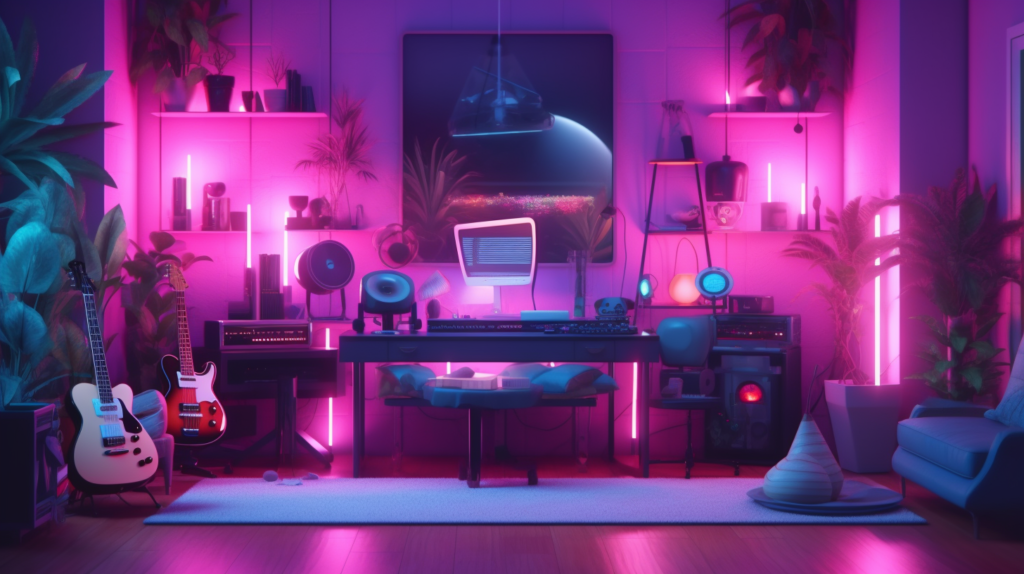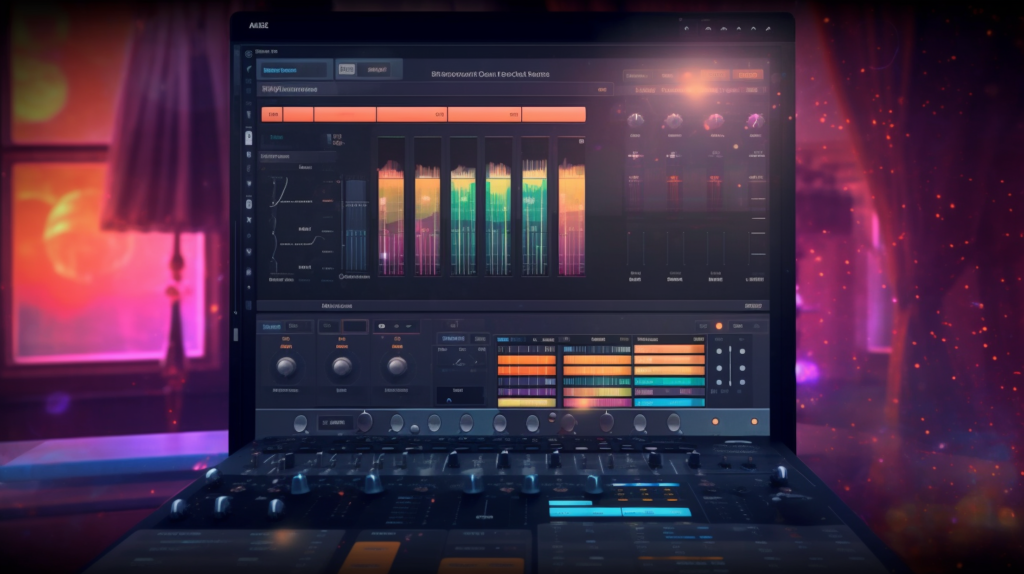
As you venture further into Astra’s landscape, it’s crucial to peel back the surface and tap into its advanced capabilities. You know the fundamentals; now it’s time to harness Astra’s full potential to set your keyboard presets apart from the masses. Start by revisiting the oscillators. You might be accustomed to the standard saw and square waves, but have you fully explored Astra’s unique harmonic oscillators? These gems can inject a complex, rich undertone into your presets, an aural tapestry that’s anything but ordinary.
While waveforms like sine and triangle have their place, pushing into the harmonic and wavetable territories opens up a spectrum of sonic nuances. Experiment with blending these waveforms, and you’ll find your presets imbued with new life. It’s about creating a soundscape that’s not just heard but felt.
And let’s not overlook the modulation sources. By now, you’re adept at using LFOs and envelopes, but have you ever dived into the modulation matrix with surgical precision? This matrix is your playground for assigning intricate modulations that respond to your every touch, elevating your presets from static sounds to living, breathing entities.
Expert Filtering: Morphing and Modulation
Filtering isn’t just about subtracting frequencies; it’s an art form in sound sculpting. Astra’s filtering capabilities are a gold mine for those willing to dig deeper. Have you experimented with the serial and parallel filter routings? By strategically placing filters in sequence or parallel, you create a myriad of pathways for your sound to evolve.
In your journey with Astra, you’ve likely used low-pass and high-pass filters. But consider the power behind the morphing filters. These filters can sweep across different types, offering a dynamic transition that can define the core of a preset. Imagine a sound that morphs from a smooth, velvety texture to a bright, cutting edge with a mere twist of a knob.
Then there’s filter modulation. Modulating your filter cutoff with an envelope is standard, but what about using a step sequencer pattern or the velocity of your playing to drive that modulation? It’s these subtle yet impactful variations that transform a good preset into a great one.
Dare to push the boundaries. Assign an LFO to the filter resonance and sync it to your track’s tempo. You’ll hear your sound pulse and breathe in rhythm, adding a layer of complexity and movement that demands attention.
In the next sections, we’ll dive into the intricacies of modulation and layering, where you’ll learn to weave a rich tapestry of sound that stands out in any mix. Stay tuned to uncover the full spectrum of Astra’s sound design possibilities.
The Nuances of Modulation
Modulation in Astra is akin to painting with sound, where each stroke adds depth and emotion to your sonic canvas. The modulation matrix is where you’ll find yourself spending most of your time, crafting movements that breathe life into every note. Let’s get technical: imagine assigning an LFO to modulate your oscillator pitch, but with a twist—map it to only affect the upper register of your keyboard. This technique adds a shimmer to high notes while keeping the lower ones grounded, creating a split personality within a single preset.
But why stop there? Dive into the sequencer in Astra and use it not just for notes but as a modulation source. Picture this: a sequence that dictates the panning of your sound, creating a rhythmic dance between left and right speakers. The key is to think of modulation not as a set of predefined routes but as an open highway, ripe for exploration.
Now consider velocity sensitivity. It’s not just about volume; it’s about character. By linking velocity to modulation depth, your presets respond with a life-like expressiveness that echoes the nuances of your playing style. A gentle touch might yield a mellow tone, while a harder strike unleashes a bright, aggressive attack. This level of control is what turns a preset into an extension of your musical intuition.
Advanced Envelope Shaping
Envelopes in Astra offer a gateway to precise dynamic control, extending far beyond simple ADSR parameters. The magic happens when you begin to employ multi-stage envelopes. These allow for loops within the envelope itself, letting you create a repeating motif that can surge and fade with a rhythm all its own.
Imagine an envelope that doesn’t just shape the amplitude but also modulates the wavetable position, cycling through different textural landscapes as the note holds. Or perhaps you assign an envelope to the effects mix, gradually introducing a lush reverb or a gritty distortion as the sound evolves.
The trick is to use these advanced envelopes to map the trajectory of your sound over time. Do you want a pad that morphs from ethereal to ominous as it sustains? Or maybe a lead that starts sharp and becomes mellow as it decays? With Astra’s advanced envelope shaping, these detailed dynamics are at your fingertips.
And don’t forget about the looping capabilities. Set your envelope to loop a segment, and you create a pulsating effect that can add rhythmic life to sustained notes. Pair this with tempo sync, and your presets will lock in with your beat, pulsing with the groove of your track.
Creative Effects Routing and Automation
Effects are not merely the icing on the cake in Astra; they can be the very ingredients that transform your presets. With Astra’s flexible effects routing, you can send any oscillator through a bespoke chain of effects, independent of the others. Consider the possibilities when you route just one layer of your multi-oscillator patch through a granular delay, leaving the rest untouched, for a sound that defies expectation.
Automation is your ally in the dynamic world of Astra. It allows you to evolve your sound throughout a track, ensuring that your presets never grow stale. Automate the mix of a bitcrusher effect to introduce grit as your chord progresses, or modulate the rate of a phaser for a swirl that syncs with your song’s energy. By recording these changes in real-time, you capture performance nuances that make your presets truly breathe.
But the real prowess in effects usage comes from unconventional assignments. Why not automate the reverb’s pre-delay to extend as a note holds, creating an expanding sense of space? Or modulate a chorus effect’s depth with an envelope for a sound that detunes over time? The goal is to craft presets that are not only sonically interesting but also responsive and dynamic, evolving with the music.
Dive into FM, RM, and Wavetable Synthesis
You’re no stranger to the power of frequency modulation (FM) and ring modulation (RM) in sound design. In Astra, these synthesis methods can yield cutting-edge sounds that stand out in any mix. FM synthesis, in particular, can impart a rich, bell-like quality to your keys or introduce a growling bass that cuts through the densest of arrangements.
Delve into the intricacies of FM synthesis by stacking multiple modulators and carriers in Astra. The interaction between these elements can produce harmonics that range from the glassy and celestial to the gritty and inharmonic. Experiment with the modulation index and envelope shaping to control the intensity and evolution of these harmonics.
Ring modulation, on the other hand, multiplies your signals, creating metallic and inharmonic overtones. Use RM to add an edge to your leads or to craft bell-like textures that resonate with a unique timbre. Adjusting the frequency of the modulating oscillator can result in everything from subtle vibrato to wild, clangorous tones.
Wavetable synthesis in Astra opens up a universe of sonic possibilities. With the ability to sweep through a variety of wave shapes, you can craft evolving textures that breathe life into your tracks. Manipulate the wavetable position with an LFO for a sound that continuously morphs or assign it to the mod wheel for real-time control during performance.
In Astra, the combination of these synthesis methods can lead to groundbreaking presets. By combining FM, RM, and wavetable synthesis, you create complex, evolving sounds that are uniquely yours. In our subsequent sections, we’ll explore how to utilize unconventional modulation sources and optimize your presets for both the studio and the stage.
Unconventional Modulation Sources
Venturing into the realm of unconventional modulation sources in Astra is like unlocking a secret door to sonic innovation. Beyond the standard LFOs and envelopes, Astra provides an array of unique modulators that can radically transform your sound. Have you ever considered modulating parameters with noise generators or the random modulation sources? These tools can inject a sense of organic evolution into your presets, making them feel alive.
Imagine utilizing a sample and hold modulator to randomize the position of a wavetable, creating a patch that never quite repeats the same way twice. Or perhaps you’re crafting a lead sound that uses noise modulation to add an unpredictable edge to each note’s attack. The beauty of these unconventional modulators is in their ability to add complexity and unpredictability, engaging the listener with sounds that are ever-shifting and full of surprises.
Assigning these modulators requires a keen ear and a willingness to embrace the unexpected. By carefully selecting the destination parameters and adjusting the modulation intensity, you can ensure that these elements enhance, rather than overpower, your sound.
Preset Optimization: From Studio to Stage
Your Astra presets are not just tools for the studio; they must also stand up to the demands of live performance. Preset optimization is key to ensuring that your patches are not only expressive but also CPU-efficient when it’s showtime. You need to strike a balance between complexity and practicality, ensuring your sounds are both impressive and playable.
To optimize for performance, consider the polyphony settings of your presets. Do you really need a pad to be 16-voice polyphonic when you’ll only play it with one hand? Reducing polyphony can save CPU load without sacrificing the essence of your sound. Also, consider disabling any unused oscillators or effects within a patch to streamline its performance.
Mapping your presets for live tweakability is equally crucial. Assigning macros to the most crucial parameters of your patch allows for on-the-fly adjustments without diving into menus. A filter cutoff, an effect mix, or an LFO rate can be mapped to your MIDI controller’s knobs or sliders, giving you immediate control over the dynamic aspects of your sound during a live set.
Case Studies and Sound Design Walkthroughs
The proof of Astra’s prowess is in the presets—those meticulously crafted patches that have graced countless productions, carving out a niche in the sound design hall of fame. As an adept Astra user, dissecting professional presets can be profoundly insightful. Each case study serves as a blueprint for understanding the application of advanced techniques in real-world scenarios.
Take, for example, a complex pad that evolves over time, morphing from a mellow, atmospheric texture into a rhythmic, pulsating element of the track. By breaking down this preset, you’ll see how modulation sources are layered and routed, how effects are blended and automated, and how every parameter is fine-tuned to achieve the desired outcome.
In your own sound design journey, these walkthroughs are invaluable. They offer a step-by-step guide to recreate and customize these sounds. You’ll gain insights into creating a classic FM electric piano sound with a modern twist, or a lush, cinematic pad that unfurls over time. Following these guides, you’ll not only replicate professional sounds but also tweak them to imprint your own signature style.
The art of sound design is about experimentation and iteration. As you apply these advanced techniques and insights from professional presets, your Astra library will become a testament to your skill and creativity, a collection of sounds that truly resonate with your artistic vision.
Performance Mapping: Astra in a Live Context
Taking Astra from the studio to the stage means understanding the nuances of performance mapping. Your presets must be malleable, responding to the twists and turns of live expression. Mapping is not just about convenience; it’s about translating your artistic intent into tactile control.
Let’s deep dive into the performance aspect. Assign your most expressive parameters to Astra’s macro controls — these are your lifelines during a performance. For instance, map the macro to a filter cutoff for a sweeping pad, allowing you to bring in brightness and cut with a single, sweeping motion. Consider the resonance control, which can add an edge to your sound as you build up to a drop. The physicality of your performance connects you to your instrument, and these macros become an extension of your creative impulse.
Velocity mapping is another technique that can add layers of expression to your playing. Assign different velocity ranges to trigger various modulation depths or effects. A soft touch could introduce a warm, subtle vibrato, while a forceful keystroke could engage a biting distortion. This dynamic control means your presets are not just sounds; they’re responsive instruments, tuned to the nuances of your performance.
Evolving Soundscapes: Astra’s Automated Environments
For the live performer, Astra can do more than just produce static sounds; it can create evolving soundscapes that react to your performance. By setting up automated environments within your presets, you engage your audience with a soundscape that’s constantly in motion, capable of reflecting the mood and energy of the moment.
Imagine a preset that begins with a simple, clean piano sound, but as you hold the keys, it begins to unfurl layers of ambient textures, thanks to a slowly rising send to a reverb or delay automated within Astra. Or consider a pad that evolves from a soft, diffuse sound into a rhythmic pattern as a sequenced filter cutoff comes into play, all automated to begin after a few seconds of sustain.
You can even automate changes in waveform shape, which is especially potent in wavetable synthesis, to transition from a smooth, rounded sound to a more complex, edgy tone. Mapping these changes to performance controls like the mod wheel or aftertouch can add an additional layer of real-time manipulation, giving you the ability to steer the evolution of the soundscape on the fly.
Creating these automated environments requires forethought—planning the journey of the sound from the moment a key is pressed to when it’s released. But the payoff is a performance that’s alive with motion, offering a richer, more engaging experience for both you and your audience.
Maintaining Vitality Across Musical Contexts
Your Astra presets must be versatile, capable of maintaining their vitality across a wide range of musical contexts. Whether you’re crafting a driving bass, a delicate lead, or a complex polyphonic texture, your presets should be adaptable, ready to slot into a mix or take center stage.
To achieve this, consider the context in which your presets will be used. A bass preset, for example, should be powerful yet not overpowering, allowing for headroom in the mix. A lead sound might need to cut through without clashing with vocals or other mid-range elements. For polyphonic textures, clarity is key; each note should be distinct, even in a dense arrangement.
One approach is to create variations of your presets with slight adjustments tailored for different musical roles. A “mix-ready” version of a preset might have a narrower frequency range, while a “solo” version could feature enhanced dynamics and more pronounced effects. By preparing these variations in advance, you can ensure that your presets always contribute positively to the overall soundscape, no matter the setting.
Finally, don’t forget the importance of musicality. Your presets are instruments, and like any good instrument, they should inspire you to play, compose, and perform at your best. By tailoring your Astra presets not just to the technical requirements of performance but also to the expressive demands of music itself, you create sounds that not only fill a space but also fulfill a creative vision.





